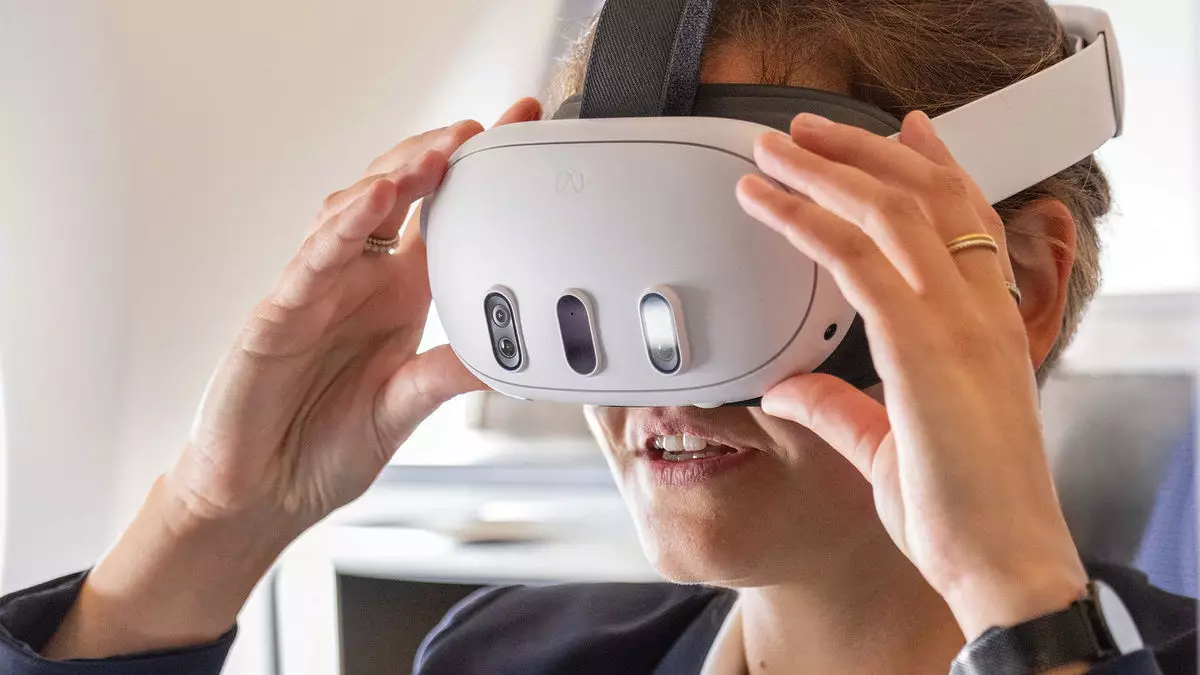As the airline industry continually evolves, it faces the persistent challenge of keeping its travelers engaged and entertained during flights. Lufthansa is stepping into this realm with a bold experiment: the introduction of Meta Quest 3 mixed-reality headsets in its new Airbus A350 Allegris business-class cabins. This forward-thinking initiative marks a significant shift away from traditional in-flight entertainment options, heralding a potential new chapter in the way passengers experience air travel. With initial tests already underway, it’s worthwhile to explore the implications of this technology and how it resonates within the broader context of in-flight entertainment.
Virtual reality (VR) and mixed reality (MR) technologies have transformed numerous sectors, and aviation is no exception. Lufthansa’s approach incorporates two modes within the headsets—the first allows users to perceive a hybrid experience of the external environment alongside digital overlays, and the second immerses them entirely in a virtual realm. Passengers are treated to various content options that blend entertainment and interactivity, including films, meditation experiences, interactive chess games, and informative destination previews.
The novel immersive aspects of watching a movie become particularly apparent in the fully virtual setting, where passengers can feel like they’re watching from an expansive cinema screen rather than adjusting their gaze to a seatback monitor. Similarly, the interactive nature of a virtual chess game effectively elevates passengers’ gaming experience, utilizing hand gestures to maneuver pieces in a way that closely mimics a real-life setup. Such innovations suggest a deeper engagement with content that traditional methods fail to achieve.
The kinesthetic nature of these headsets may particularly resonate with tech-savvy travelers. For flying passengers, especially those limited to confined seating, the capability to ‘pick up’ a virtual chessboard or explore a destination through simulated flight can transform the dreariness of long-haul flights. As passengers gear up for their trips, the opportunity to survey a virtual representation of their destination prior to landing could enhance their excitement, providing a richer contextual backdrop for the experience that awaits.
Furthermore, the possibilities become even more thrilling when expanding the discussion beyond entertainment. Bjoern Becker, Lufthansa’s head of future intercontinental experience, hinted at the lucrative prospects of VR technology, particularly in regard to in-flight merchandise exposure. Imagine passengers taking virtual test drives of cars or participating in interactive shopping experiences mid-flight. This model not only aims to boost passenger satisfaction but also offers airlines potential revenue streams, showcasing a dual advantage for both customers and carriers.
However, while Lufthansa strides ahead in this experimental landscape, not all stakeholders share the enthusiasm. Executives from other major airlines express a cautious stance toward the viability of VR headsets as a mainstream entertainment solution. For instance, Delta Airlines’ managing director of customer experience, Ekrem Dimbiloglu, presented a contrasting perspective by emphasizing the prevalent appeal of seatback entertainment systems. The statistics paint a clear picture: a majority of flyers still gravitate towards traditional screens that offer reliable engagement throughout their journey.
Dimbiloglu noted that while VR may flourish in domestic settings, it remains uncertain whether this technology will genuinely resonate with passengers seeking comfort and familiarity during flights. Additionally, Aeromexico’s Antonio Fernandez shared a similar sentiment, underscoring the fact that the dreams of a VR-dominated cabin experience might be too ambitious for the next decade. Insights from these industry veterans reveal a complex market understanding, suggesting a balancing act that may favor the continuance of established in-flight entertainment models alongside innovative technologies.
It seems inevitable that the future of in-flight entertainment will involve some form of integration between traditional media and new-age technologies. As VR headsets become more compact and affordable, they may slowly encroach upon the spaces occupied by conventional systems. Travelers accustomed to bringing personal devices on flights could gradually create a demand for airlines to provide more VR options, ushering in a symbiotic relationship between passenger gadgets and in-flight technology.
As the industry evolves, established technologies like seatback screens will likely not vanish but adapt. Innovations like Lufthansa’s VR headsets offer tantalizing glimpses into what future flights might hold, inviting travelers into immersive journeys that transcend current entertainment paradigms. Ultimately, the evolution of air travel as an experience maintains its complex interplay between tradition and innovation, hinting at an exciting horizon laden with potential for both passengers and airlines.


Leave a Reply